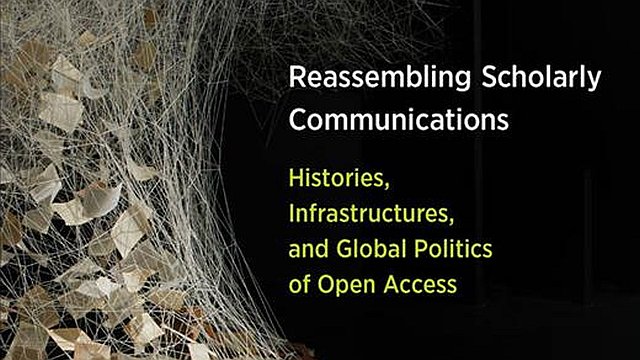
Open access to scholarly knowledge in the digital era: Introduction
This article is the introduction of a series of articles summarising the book Reassembling Scholarly Communications: Histories, Infrastructures, and Global Politics of Open Access.
It can be tempting to view digital publishing in terms of a fundamental paradigm shift; a “disruptive innovation” that breaks as radically with its print past. Yet path dependencies and social histories from print forebears condition the ways in which publishing acts in the digital space.
The resulting questions of intersecting traditions and technologies have relevance for the ongoing rapid transformations of research and learning that are taking place in the early twenty-first century. It is to this issue that this series is devoted.
Open access models
Open access refers to conditions under which price and permission barriers for accessing peer-reviewed research work are removed. With the move of publishing to the digital space, the Open Access Movement proposed to make research work freely available to anyone who wishes to read it.
This stance is premised on the idea that education is fundamentally different to other forms of commodity in two ways. First, in that education should be freely available to anyone, since a widespread well-educated population has a public benefit. Second, in that higher education, where much research is produced, operates on an economic model that is conducive to this. This is because academics are not paid based on the volume of their research that is sold but are rather given a salary to conduct the research work because it has social, scientific, or humanistic importance.
There are several forms of open access, usually assigned on a color spectrum of “gold” and “green.” Gold open access refers to conditions where a publisher makes the material openly available to read and reuse. By contrast, green open access refers to instances where an author deposits a version of the work into a subject or institutional repository.
A thorny issue
When couched in terms of the ideal of a world in which nobody was unable to access research material that could further their understanding of the universe, open access sounds easy, logical, and almost inevitable. However, the social, technical, and economic conditions of academic research publication practice make the entire endeavor far thornier than might be imagined.
On the economic side, scholarly publishing is big business. For those entities whose existence depends on profiting from selling research publications, open access poses a potentially serious threat. Indeed, for publishing entities that have staff and bills to pay, open access implies a change in business practice.
Open access both radically changes the distribution of payments from the subscription environment that has existed for many years while also creating new exclusions. By reducing the ways in which payments are currently distributed – from hundreds or thousands of subscribers around the world all paying less than the cost of an article and moving instead to a single payer who must cover the entire cost – the processing charge model effects a substantial concentration of costs within high-output, research- producing universities.
In the subscription model, each subscriber pays a relatively small amount for access to a published research article or book. This spreads publishing costs across numerous subscribers, but limits access to only those subscribers. On the other hand, for gold open access, a single article processing charge (APC) or book processing charge (BPC) is paid which allows anyone to access the published article or book free of charge. A problem arises though if the APC or BPC can’t be paid – this means that rather than open access, the result is no access.
Another alternative model has been proposed to help with the economics. This is consortial open access, which involves a group of people collectively paying the publishing costs. However, they let everybody else freely access any published material for which they have paid, in expectation of reciprocity and for the public good. This model spreads costs and allows broader access than the subscription model, but some are worried that they may pay while others might not return the favor.
There are also arguments that publishing fees are extortionate, A large proportion of the fees are pure profit for the publisher, with the motivation being return for its shareholders rather than the dissemination of research.
The situation is even worse when it comes to open access books, for which the production costs are much, much higher. The economics of distribution – at the global, national, institutional, and disciplinary levels – are critical to our understanding of what it means to transition to a world in which academic content is free on the reader side, even while it is not free to produce or, importantly, to publish.
Neoliberalism and access to knowledge
Among accusations that open access will encourage plagiarism, or degrade the quality of academic work, has come the more recent assertion that open access is entangled with the neoliberalization of academia and the academy, as well as the commodification and platformization of online spaces and digital infrastructures. Neoliberalism can be defined as the extension of economizing, quantifying thought to all areas of life and, in particular, the replacement of politics with economics.
It is easy to chart a narrative of neoliberal incursion into higher education. In the UK, for instance, there is apparent confirmation in the proliferation of target-driven assessment mechanisms and financialization. This extends to scholarly publishing. For example, the recent demands that Stanford University Press be self-sustaining – that is, as a revenue, rather than cost, center for the university – can be and have been read in the light of neoliberal politics.
The actual history of higher education is more complex than this. Higher education had an unequal and checkered history long before it became neoliberal. Overly linear and simplistic narratives of the purpose and context of structures such as the Research Excellence Framework (REF) in the UK do not capture the whole story. For example it is not likely that new, younger universities would have been given a share of the funding pie without mechanisms such as the REF.
That said, open access has become associated, for better or worse, with such assessment mechanisms. Over the previous two decades, research funders realized that who pays the piper calls the tunes and they began mandating for open access to publicly funded research work. This has led to the unfortunate situation in which many scholars encounter open access for the first time as a product of a need to comply with systems of bureaucracy and finance, rather than any genuinely critical engagement with scholarly communication practices in the digital age. From this entanglement comes the critique that open access is a means by which neoliberal government agendas of “knowledge transfer” and “impact” can be forced upon researchers.
In particular, criticism has fallen on the more liberal of the Creative Commons licenses and especially those without a NC (noncommercial) or ND (nonderivative) clause. Prominent commentators have voiced fears that without a noncommercial clause, private higher education providers (who can issue degrees without doing any teaching in the UK, for instance) will swoop in to bundle open access research content into textbooks, thereby undercutting the research university in its present form. Given the current standard of discourse around higher education in government policy circles, this is far from an irrational fear.
Unfortunately, though, the law is often unhelpful when it comes to the interpretation of the “noncommercial” clause. Often, charitable organizations – with missions that we might wish to support for ethical reasons – conduct “commercial” activities in order to fund their operations. Indeed, universities are commercial in this sense. Likewise, in terms of allowing derivatives, or otherwise, it is unclear whether a course pack that used a mere excerpt might be ruled as a derivative rather than a compilation. In the quest to fight neoliberalization, the arguments against open licensing find themselves spinning too broad a web and, in the process, catching legitimate scholarly uses that could be worthwhile.
The response has, on occasion, been to call for new licenses. However, Creative Commons licenses have been developed and legally tested over decades by some of the finest legal minds in the world. To rewrite them for scholarly purposes would be extremely difficult.
Yet the fundamental contradiction remains that those who most loudly protest, say, precarious working conditions within universities, but who also contest open access on the grounds that it is neoliberal, find themselves in a double bind. For in perpetuating the unequal situation of access to research, which remains the precondition for producing further research and thereby securing a faculty position, those who disdain open access become those who uphold a system which remains extremely difficult for those outside of the university to benefit from and participate in.
Further, it is hard also to ignore the fact that worldwide access to scholarship from the Global North is almost exclusively the preserve of scholars from this region. In attacking the claimed neoliberalism of open access in general – as opposed, to say, just the APC model – such scholars (inadvertently) uphold a system of neocolonial access to knowledge, as several commentators in this series point out.
It is also curious that often those most opposed to the supposed neoliberalization of the academy are also those who will speak, in throwaway comments, of “top journals” and the importance of their perpetuation. But it is this reliance on a proxy measure for quality – Impact Factors or even just prestige – that allows the neoliberal systems of assessment to continue to function.
This evaluative reliance on “containers” is entangled with the current system of open access. For instance, in its recent IPO, SpringerNature explicitly noted that “[s]ome of our journals are among the open access journals with the highest Impact Factor, providing us with the ability to charge higher APCs for these journals than for journals with average Impact Factors.” Elsevier, the largest scientific publisher in the world, notes that its pricing of open- access fees is also based upon measures of the journal’s standing, rather than purely upon the labor the publisher has provided through its services. Research material has become a positional good, in which the status of the venues in which it appears bear more upon its market worth than the actual content of the work.
Such a stance only makes clear what has been fairly obvious to anybody in an academic library purchasing department for some time: that the symbolic economy of prestige in academia translates into a real-world financial economy. Indeed, what appears as a matter of academic judgement and of practices protected by laws of academic freedom has dire market consequences for access to knowledge around the world. Choices by academics of where to publish – on one set of criteria of appraisal – determine the ability of people around the world to afford access to that work.
An alternative frame of reference
All of this is to say that open access is intensely messy. Open access is perceived through a set of contested institutional histories, argued over various theoretical terrains in the present, and imagined via diverse potentialities for the future. And it is at this point, amid such an untidy set of circumstances, that this series makes its intervention. At the present moment, we are over-determined by an inflexible historical understanding of open research practices that risks leading us into either overly instrumental conceptions or critiques that foreclose the possibility of other arrangements.
How might our thinking differ if we had an alternative historical frame of reference? What experiments have people conducted, in the present, that might lead to other possible trajectories? And what different futures can we foresee, even as we are historically determined in our imagination, from our current vantage point?
The following sections serve as introductions to different perspectives, as gateways to alternative approaches. For it is only in the documentation of practical enterprises that one can see the forks in history’s otherwise apparent determinism. That is, in hindsight everything can appear as though it could never have been different. By describing efforts to change the future, in our present, from around the world, the notion of “history as timeline” may be complemented by another conception of contingent branching events.
Next part (section 1): Colonial influences.
Article source: This article is an edited summary of the Introduction of the book Reassembling scholarly communications: Histories, infrastructures, and global politics of Open Access1 which has been published by MIT Press under a CC BY 4.0 Creative Commons license.
Article license: This article is published under a CC BY 4.0 Creative Commons license.
References:
- Eve, M. P., & Gray, J. (Eds.) (2020). Reassembling scholarly communications: Histories, infrastructures, and global politics of Open Access. MIT Press. ↩
Also published on Medium.




